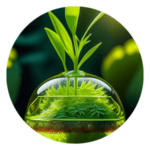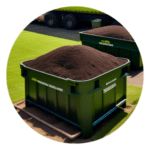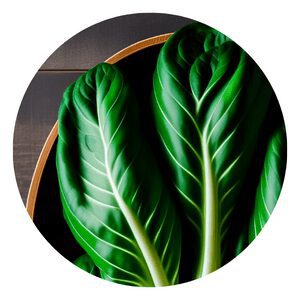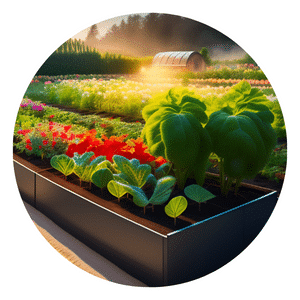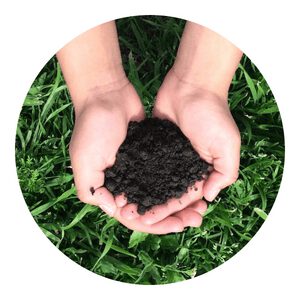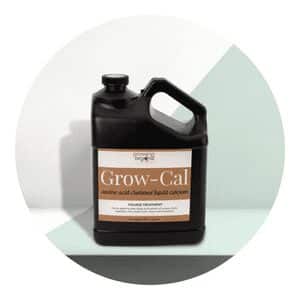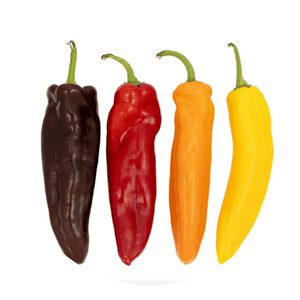The Best Vegetables to Grow Indoors for a Year-Round Harvest
If you’re looking to grow your own vegetables indoors, year-round, fret no more!
With a few modifications to your home, you can create the ideal environment to easily harvest delicious and nutritious vegetables all year.
Whether you’re an experienced gardener or a beginner, this article will provide you with essential information on which vegetables are best suited for indoor growing and the steps needed to cultivate them.
From lettuce to broccoli, there is something for everyone to enjoy regardless of what season it is.
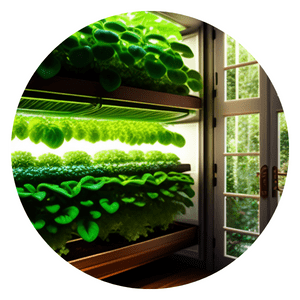
Indoor Vegetables Menu
Criteria for selecting indoor vegetables
When it comes to indoor vegetable gardening, choosing the right plants is essential for a successful harvest.
Here are some criteria to consider when selecting indoor vegetables:
Light requirements: Most vegetables require a minimum of six hours of sunlight per day.
However, some vegetables like leafy greens and herbs can tolerate less light, making them ideal for indoor gardening.
Choose vegetables that match the available light in your indoor space.
Space requirements: Indoor vegetable gardening requires containers or grow bags to hold the soil and plants.
Vegetables that are compact and have shallow roots, such as lettuce or radishes, are ideal for small containers.
Larger vegetables, such as tomatoes or peppers, require more space.
Growth rate: Some vegetables grow faster than others.
Vegetables with a faster growth rate, such as herbs or leafy greens, can provide a quick harvest and continuous supply of fresh produce.
Yield potential: Consider the yield potential of each vegetable.
Vegetables that produce large amounts of fruit, such as tomatoes or peppers, can provide a bountiful harvest.
However, they may require more care and attention.
Nutritional value: Choose vegetables that are nutrient-dense and provide a variety of vitamins and minerals.
Leafy greens, such as spinach or kale, are rich in vitamins A and C, while root vegetables like carrots and beets are a good source of fiber and antioxidants.
By considering these criteria, you can select indoor vegetables that will thrive in your space and provide a continuous supply of fresh produce.
Remember to choose vegetables that match your experience level, available time, and space.
With proper care and attention, indoor vegetable gardening can be a fun and rewarding experience.
Leafy greens
Leafy greens are some of the most versatile vegetables to grow indoors.
They are relatively easy to cultivate, requiring little space and maintenance.
Many varieties of leafy greens can be harvested in as little as four weeks, making them a great choice for those with limited garden space or time.
From lettuces like romaine and butterhead to kale, chard, collards, spinach and more – there’s something for everyone when it comes to growing leafy greens indoors.
When choosing which type of leafy green to grow inside your home, consider the climate you live in and the amount of sunlight available.
Leafy greens such as lettuce are best grown in a cool environment with indirect sunlight or fluorescent light fixtures.
More hardier varieties such as collards and kale should be grown near a window that receives full sun for most of the day during peak summer months; otherwise they thrive on just four hours of direct sun per day during cooler months.
To keep your plants healthy while growing indoors, it’s important to provide good drainage so that water can easily escape from their soil-less potting mixture and not become overly saturated with moisture.
To ensure proper drainage of your indoor garden bedding material use an organic matter like compost or peat moss at least once a month – this will help hold moisture in while allowing excess water to escape freely through its porous structure.
Spinach
Spinach is an ideal vegetable to grow indoors, as it can be harvested in a short amount of time.
This leafy green grows quickly and produces a large yield with minimal effort.
Its delicate leaves are perfect for salads and sandwiches, or used as a nutritious addition to many other dishes.
Spinach thrives in cooler temperatures, making it easy to cultivate inside all year-round.
It also requires little space for its growth, which can be beneficial for those with limited indoor gardening space.
The best way to start spinach from seed is by using seed trays and transferring the sprouts when they reach 3 inches tall into individual pots or planters.
Once planted the soil should remain moist but not soaked, and spinach should receive 6 hours of direct light per day for optimal growth.
As its leaves mature more fertilizer may be necessary; however too much can cause bolting which will render your crop unusable.
With regular harvesting you should have fresh spinach available throughout the winter months!
Lettuce
Lettuce is one of the most popular vegetables to grow indoors, since it grows quickly and can provide a steady crop throughout the year.
It produces tender leaves that are great for salads and sandwiches, as well as crunchy hearts that add texture and flavor to dishes.
When growing lettuce indoors, use containers with drainage holes and a quality soil mix.
Make sure to keep the soil damp but not wet and place in an area that receives plenty of bright light.
When planting lettuce indoors, look for varieties specifically bred for indoor growth or those labeled “heat tolerant” or “slow bolt.”
These will be more resistant to bolting (producing a flowering stalk) when exposed to warm temperatures or too much direct sunlight.
For best results, sow seeds every two weeks so you have a continuous harvest of fresh lettuce over time.
Harvesting can be done by snipping off individual outer leaves when needed; leave some intact so new leaves continue to grow in their place.
Since lettuce is sensitive to cold temperatures, take care not to let it get exposed during colder months – either move containers inside or cover them with frost-resistant fabric if necessary. With proper care, you should be able enjoy freshly harvested lettuce all year round!
Kale
Kale is one of the most popular vegetables to grow indoors, due to its ability to thrive in cool temperatures and shady conditions.
Kale requires very little maintenance, making it a great choice for novice gardeners. It is easy to care for and can be harvested year-round.
When growing indoors, you’ll need just enough light from windows or artificial lighting sources like fluorescent bulbs; the ideal temperature range is between 60 to 75 degrees Fahrenheit.
Kale prefers moist soil that is well draining but not too wet.
When it comes time for harvesting, make sure you only take what you need so the plant will continue producing throughout the season.
You should also rotate your kale plants every few weeks to ensure even growth and get the most out of your harvest!
Herbs
Herbs are one of the easiest and most rewarding vegetables to grow indoors.
They don’t require a lot of space, they can be grown in containers, and they can be harvested all year round.
Some of the best herbs that you can easily grow indoors include basil, chives, cilantro, oregano, parsley and sage.
Basil is a great herb to start with as it is easy to care for and thrives in the right conditions.
To get started growing basil indoors you will need a sunny window or artificial lights and well-draining soil.
You should also water your plant frequently but make sure not to over water it as this can lead to root rot.
Once established your basil plants will produce fragrant leaves that you can use for salads or pesto dishes.
Chives are an ideal choice if you have limited space as they only grow up to 8 inches tall when mature and don’t need a large container for growth.
They thrive in full sun but do well with some partial shade during hotter months of summertime too.
When harvesting chives make sure not to cut more than 1/3rd of the plant off at any one time and only use clean scissors when doing so – this helps promote healthy regrowth after harvesting.
I bring to you my seeds of fruits and vegetables green - Organic, hearty, and just right for any gardening scene. With indoor growth then you can harvest throughout the year - Your own natural bounty without a single fear! As taste grows sweeter, nutrition soaks within - Fruits and vegetables that are growing from within. Be it herbs or tomatoes, they’ll be organic you'll realize - Grow indoors what could come in fruitful surprise!
Chappy The Gardener
Basil
Basil is an essential herb for any home cook and it can be grown indoors year-round.
It’s easy to grow from seed, requires minimal maintenance, and thrives in a sunny windowsill or under artificial lighting.
As a bonus, basil leaves are packed with nutrients like iron, magnesium and vitamin A.
When grown indoors, basil does best with regular watering and occasional fertilization.
When the plants reach about six inches tall they should be trimmed back to encourage new growth.
To harvest basil leaves, simply pinch off individual leaves as needed or snip entire stems at once if the plant is large enough.
Basil can be stored by freezing or drying the leaves or by adding them to olive oil and storing in the refrigerator for up to two weeks.
Parsley
Parsley is a popular herb that can be grown indoors. It is an easy to grow plant, requiring only a pot of well-draining soil and regular watering.
Parsley prefers bright light, but will tolerate lower light levels as long as it isn’t too dark.
The best time to harvest parsley is when the leaves are young and tender.
For continuous harvests, stagger planting by two weeks for continual supplies of fresh parsley throughout the year.
When harvesting, cut only what you need; the more you take from your parsley plants, the quicker they will produce again.
Parsley can last up to one week in a refrigerator if stored properly in an airtight container or bag with some moisture inside.
With its vibrant flavor, parsley makes an excellent garnish or addition to salads, soups, sauces and stews.
Parsley also contains many beneficial vitamins and minerals such as Vitamin A, Vitamin K and Iron which help promote healthy vision and boost immune system functioning respectively.
Additionally, it has anti-inflammatory properties which may help reduce inflammation in the body caused by arthritis or other chronic conditions.
The best part about growing this herb indoors is that it can be used freshly picked from your very own garden whenever you want!
Thyme
Thyme is a perennial herb with small, gray-green leaves and a powerful flavor.
It is used in many cuisines around the world, including French, Italian, Spanish, Greek, Moroccan, and Middle Eastern.
Thyme grows well indoors in containers on a sunny windowsill or under artificial lighting such as fluorescent tubes or LED bulbs.
When grown indoors you can expect to have thyme available year-round. Plant thyme seedlings in well-draining soil and keep them moist but not soggy.
Fertilize every few weeks with an organic fertilizer or compost tea to ensure optimal growth.
Prune regularly to encourage bushy growth and harvest sprigs as needed for cooking.
Thyme pairs well with many dishes including soups, stews, sauces, salads, egg dishes and roasted vegetables.
Use it fresh or dried for maximum flavor – use sparingly when using dried thyme as its flavor is more concentrated than fresh thyme leaves.
Root vegetables
Root vegetables are a great choice for growing indoors, as they can be harvested throughout the year and require minimal space.
Carrots, potatoes, turnips, parsnips and beets are among the most popular root vegetables to grow indoors.
Carrots can be grown in containers or in window boxes filled with soil; they should get at least six hours of sunlight each day.
Potatoes will need larger containers—at least 12 inches deep—and some newspaper or straw on top of the soil to help keep them warm and protected from light.
Turnips, parsnips and beets also thrive in shallow containers filled with potting soil that is kept moist but not soggy; they prefer cooler temperatures in order to ensure good growth.
When harvesting root vegetables indoors, take care not to disturb their roots too much as it could damage them.
It’s best to cut off what you need from the plant instead of pulling it out of the ground.
By following these simple instructions for how to grow root vegetables indoors, you’ll have an abundant supply all year round!
Carrots
Carrots are an excellent choice for a year-round harvest as they require little space, minimal care, and can be grown in a range of soils.
When planted indoors, carrots need sunlight for at least six hours per day and should be watered regularly.
The soil should also remain moist but not soggy to ensure optimal growth.
Carrots can be direct-sown onto the surface of the soil or planted into containers that have been filled with potting mix.
It is important to thin out the seedlings once they reach two inches high to give the remaining plants enough room to grow.
Harvesting usually takes place when the carrots are approximately three inches long and yields will depend on how many seeds were planted initially.
For maximum yield, it’s best to plant new sets every one to two months throughout the indoor growing season.
Carrots are a great source of vitamins A and K as well as dietary fiber, so adding them into your indoor garden is sure to benefit both you and your family’s health!
Radishes
Radishes are one of the most popular vegetables to grow indoors and they can be harvested year-round.
They are very easy to care for, needing only water and sunlight, and they grow quickly – in as little as three weeks!
Radishes come in a variety of sizes, shapes, and colors including white, red, pink, black and even purple varieties.
Although radishes are often eaten raw or used in salads, there are also many other ways to enjoy them.
Roasted radish dishes have become increasingly popular over recent years.
Roasting brings out their sweetness and it is an easy way to prepare them that brings out their flavor without overpowering it with strong spices or sauces.
Another classic way of preparing radishes is pickling them with vinegar or beer – this creates a delicious crunchy flavor that works well on sandwiches or burgers.
If you’re looking for an easy vegetable to start your indoor gardening journey then look no further than radishes – they’ll provide a bountiful harvest all year long!
Beets
Beets are an excellent vegetable to grow indoors, as they require very little space and are quite rewarding.
They can be harvested at any stage of growth for a variety of uses, from salads to pickles.
Beets thrive best in cool temperatures and partial shade, making them ideal for indoor gardens.
Beet seedlings should be planted in early spring when the soil has warmed up enough for them to germinate.
Plant the seeds 1/2 inch deep and 2 inches apart in a shallow pot or container with well-drained soil.
Beet plants may take up to two months to mature, but once they reach the proper size, you can start harvesting their delicious roots and leaves.
To harvest beetroot roots, simply twist them off at ground level; no digging is necessary!
Harvesting beet leaves is also simple—just snip off a few leaves near the top of each plant every few weeks.
To keep your beet plants healthy and productive all year round, provide plenty of water throughout the growing season and fertilize regularly with an organic fertilizer blend that’s rich in nitrogen, phosphorus, potassium (NPK).
If you’re keen on achieving bigger root sizes with your beets, mulch around each plant before flowering begins so that new root growth will stay moist while avoiding direct sunlight exposure which can cause scorching on their skins.
Tomatoes
Tomatoes are one of the most popular vegetables, and many people grow tomatoes indoors for a year-round harvest.
They can be grown in any size container and work best in a potting mix that has good drainage.
To ensure optimal growth, fertilize your tomato plants regularly with an organic fertilizer that is specially formulated for edible plants.
It’s also important to provide adequate light for your tomato plants; typically, it’s best to position them near east or south-facing windows where they will receive plenty of sunlight.
Additionally, it’s important to keep the soil evenly moist but never soggy; too much water can result in fungal diseases such as root rot.
Pruning is necessary to encourage bushier growth and larger tomatoes; simply pinch off the topmost leaves when the plant reaches about 12 inches tall.
With regular care, you should have delicious homegrown tomatoes within months!
Peppers
Peppers are a great vegetable to grow indoors because they thrive in warm climates.
In addition, peppers come in many different colors, shapes and sizes, so you can create a beautiful display of peppers on your windowsill.
Peppers are also low-maintenance plants that require minimal care; simply give them consistent water and sun exposure.
Depending on the variety you choose, most peppers will produce an abundance of fruit for months at a time.
You can even find pepper varieties that will produce year-round! To get started growing peppers indoors, choose from the bush or vining varieties such as bell peppers and jalapenos respectively.
Once your pepper plant has established itself with a strong root system and healthy leaves, it’s ready to start producing!
Make sure to have quality potting soil and adequate drainage as well as ample direct sunlight throughout the day for best results. With just a few simple steps, you can enjoy fresh homegrown peppers all year long!
Tips for growing indoor vegetables
Growing indoor vegetables is a great way to have fresh produce year-round, but it can be challenging to get started.
Here are some tips to help you grow healthy and thriving indoor vegetables:
Choose the right container: The container you choose should have proper drainage and be the right size for your plant.
Too small of a container can lead to stunted growth, while too large of a container can cause overwatering and root rot.
Provide adequate light: Vegetables need plenty of sunlight to grow.
Place your plants near a south-facing window, or use grow lights if your space lacks natural light.
Most vegetables need six to eight hours of sunlight per day.
Use high-quality soil: The soil you use should be rich in nutrients and have good drainage.
Choose a high-quality potting mix that is specifically formulated for vegetables.
Water properly: Overwatering can lead to root rot, while underwatering can stunt growth.
Water your plants when the top inch of soil is dry, and avoid letting the soil dry out completely.
Fertilize regularly: Indoor plants need regular fertilization to replenish nutrients.
Use a balanced fertilizer every two to three weeks during the growing season.
Control humidity: Indoor environments can be dry, which can stress your plants.
Use a humidifier or place a tray of water near your plants to increase humidity.
Watch for pests and diseases: Indoor plants are still susceptible to pests and diseases.
Keep an eye out for any signs of infestation, and take action immediately if you spot a problem.
By following these tips, you can grow healthy and thriving indoor vegetables.
Remember to choose the right plants for your space and experience level, and to provide proper care and attention.
With a little patience and dedication, you can have a bountiful indoor garden that provides fresh produce all year long.
In conclusion, growing vegetables indoors is an excellent way to ensure a supply of fresh produce all year round.
No matter what size space you have, there’s an option for everyone from mushrooms to tomatoes.
Furthermore, you can save money and reduce waste by planting your own food.
The key to success is choosing the right varieties of vegetables and providing them with the necessary light, water, soil, and nutrients for optimal growth.
By following these guidelines, anyone can enjoy fresh produce throughout the year!
Click To Grow
Helps Us Grow – Share If You Like



